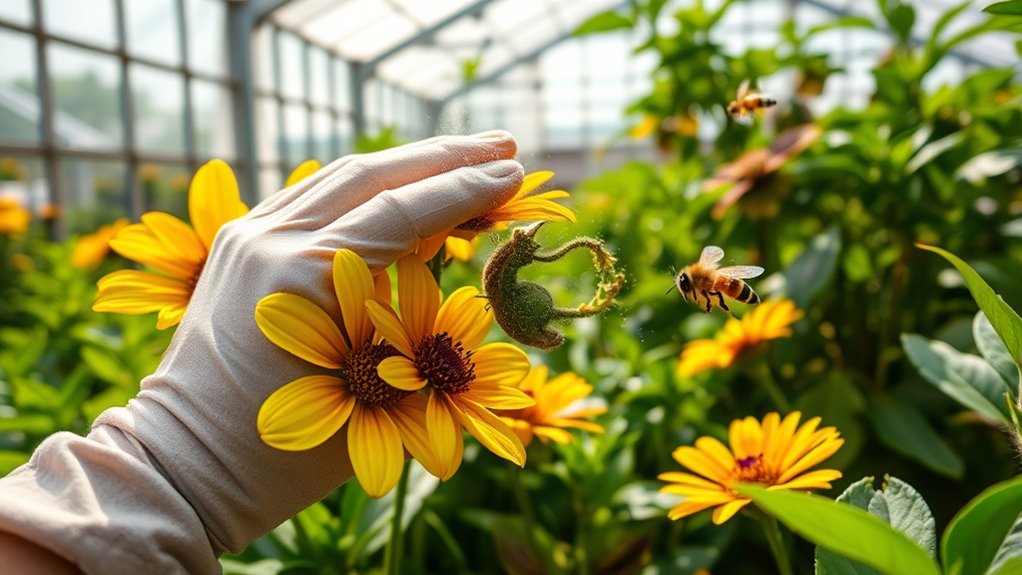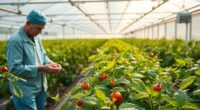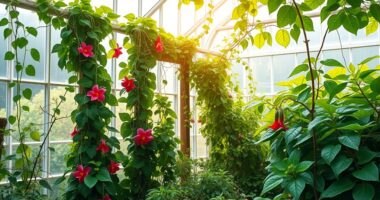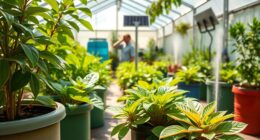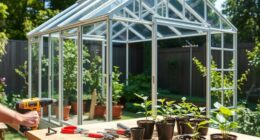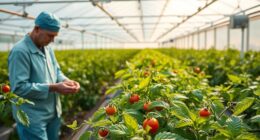To effectively pollinate in greenhouses, you can manually hand pollinate by gently transferring pollen with small brushes or shaking flowers when they’re receptive. To attract natural pollinators like bees, create suitable habitats, provide access points, and introduce managed colonies like bumblebees, which work well in enclosed spaces. Combining both methods guarantees higher yields and better crop quality. Keep exploring for more tips on optimizing your greenhouse pollination efforts.
Key Takeaways
- Hand pollination involves manually transferring pollen to ensure fertilization when natural pollinators are unavailable.
- Using tools like brushes or shaking flowers helps improve pollination accuracy and crop quality.
- Introducing managed bees, especially bumblebees, can naturally enhance pollination in greenhouse environments.
- Creating access points and suitable habitats encourages bee activity and supports effective pollination.
- Combining hand pollination with attracting pollinators maximizes fruit set, uniformity, and overall crop yield.
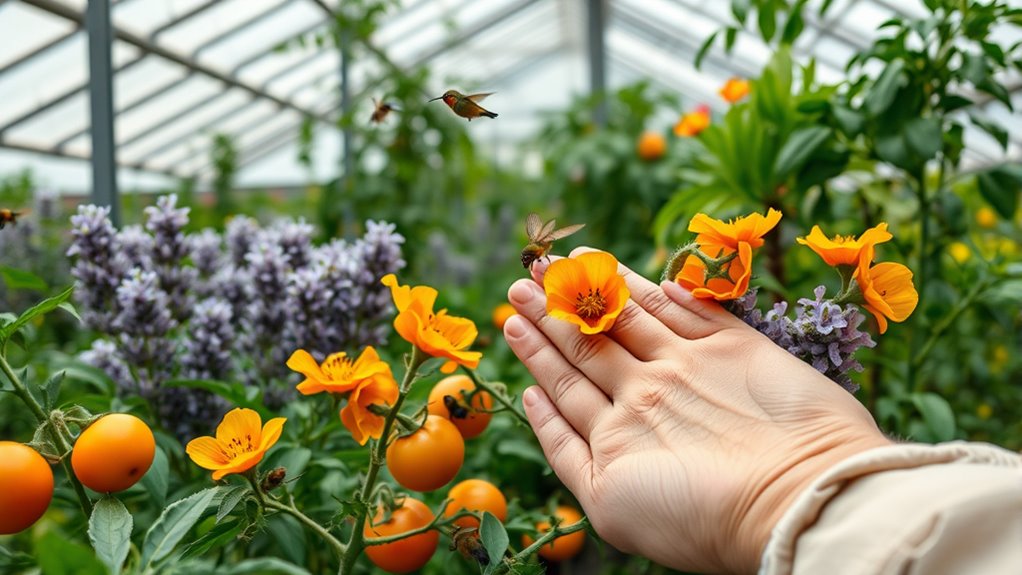
Have you ever wondered how plants in greenhouses get pollinated without the natural presence of outdoor pollinators? The answer lies in the careful application of pollination techniques and effective greenhouse bee management. Since outdoor pollinators like bees and butterflies can’t always access enclosed environments, growers need to take matters into their own hands to guarantee successful fertilization and fruit production. Hand pollinating and attracting pollinators are two primary strategies used to mimic natural pollination processes inside greenhouses.
Hand pollinating involves manually transferring pollen from the male part of a flower to the female part. This can be done with a small brush, cotton swab, or even by gently shaking the flowers to release pollen. It’s a precise method that allows you to control pollination timing, which is essential for maximizing fruit set and quality. Hand pollination is especially effective for crops like tomatoes, peppers, and strawberries, where natural pollination might be limited due to the absence of outdoor pollinators. It requires attention to detail and consistency; you need to identify the right flowering stage, usually when the flowers are receptive, and guarantee that pollen is transferred efficiently. This method is labor-intensive but guarantees that each flower receives pollen, leading to higher yields and uniform quality. Utilizing pollination timing techniques ensures that the pollination occurs at the optimal moment for each crop.
Hand pollination ensures precise pollen transfer, boosting yields in greenhouse crops like tomatoes and strawberries.
In addition to hand pollinating, managing greenhouse bees plays an important role in pollination techniques. Greenhouse bee management involves introducing managed bee colonies into the environment, creating conditions that attract and retain these beneficial insects. Bumblebees are often preferred because they are effective at buzz pollination—a technique where they vibrate flowers to release pollen—making them ideal for crops that benefit from this process. To successfully manage greenhouse bees, you need to maintain a suitable habitat, provide access points, and ensure the health of the colonies. Proper management minimizes stress on the bees and maximizes their activity, guaranteeing consistent pollination. This approach not only boosts pollination efficiency but also reduces the labor involved in hand pollination, especially for larger operations.
Combining hand pollination with strategic greenhouse bee management offers a complete approach to guarantee crops get adequately pollinated in a controlled environment. While hand pollinating gives you precision, attracting and managing bees can enhance natural pollination, leading to healthier plants and higher yields. Both methods require understanding your crops’ specific needs and environmental conditions. With the right techniques, you can effectively mimic natural pollination, guaranteeing your greenhouse crops thrive even without outdoor pollinators.
Frequently Asked Questions
How Do Temperature and Humidity Affect Greenhouse Pollination?
You’ll find that proper humidity control and temperature regulation are vital for effective greenhouse pollination. High humidity can cause pollen to become sticky, reducing its viability, while low humidity dries out pollen, making it less effective. Similarly, maintaining ideal temperatures ensures pollen stays viable and flowers are receptive. By managing these factors, you improve pollination success, whether you’re hand pollinating or attracting natural pollinators, leading to healthier crops.
Can Artificial Lighting Influence Pollination Effectiveness?
Artificial lighting acts like a conductor guiding your greenhouse’s pollination symphony. It can influence pollination efficiency by mimicking natural light cues, encouraging pollinators or even aiding hand pollination efforts. By adjusting the spectrum and intensity of artificial lighting, you create an environment that boosts pollination success. This strategic use of light guarantees your plants receive the best chances for fruit and seed development, making your greenhouse thrive.
Are There Specific Pollinators Best Suited for Certain Greenhouse Crops?
Yes, certain pollinators are better suited for specific greenhouse crops based on pollinator preferences and crop-specific pollination needs. For example, bees work well for fruiting plants like strawberries, while butterflies may be more effective for flowering ornamentals. You should match the pollinator type to your crop’s requirements, ensuring ideal pollination and yield. Understanding pollinator preferences allows you to select the most effective species for your greenhouse.
How Often Should Hand Pollination Be Performed for Optimal Yield?
You should perform hand pollination on a regular basis, ideally every day or every other day, to keep the pollination schedule on track. Consistency is key—don’t let your efforts fall through the cracks. Monitoring your plants for signs of pollination activity helps determine the right pollination frequency. This way, you guarantee your crops stay well-pollinated, preventing missed opportunities and keeping your yield on the up and up.
What Are the Signs of Unsuccessful Pollination in Greenhouse Plants?
If you notice poor fruit development or no fruit forming, it’s a sign of pollination failure. You might see flowers that don’t set fruit or shriveled, undeveloped berries. Discoloration or flowers dropping prematurely also indicate unsuccessful pollination. These issues suggest the pollination process didn’t occur properly, so you should consider hand pollinating again or attracting more pollinators to enhance fruit set and guarantee healthy growth.
Conclusion
In your greenhouse, pollination is like a dance where you’re both the conductor and the partner. Whether you’re hand-pollinating or inviting nature’s tiny workers, you’re helping your plants sing their sweetest songs. Think of each pollination as planting a seed of life, turning your greenhouse into a vibrant symphony of growth. With a little effort and a touch of nature’s magic, you’ll see your garden flourish like a blossoming dream, full of color and energy.
